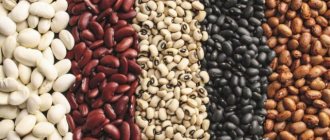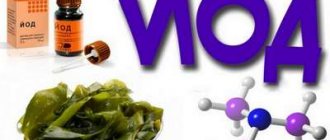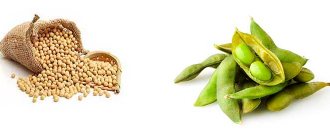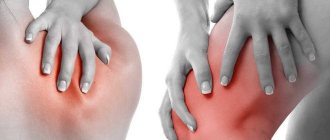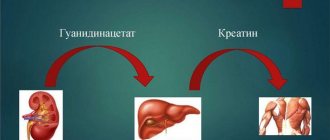The name “gluten” (derived from the English glue) is a complex plant protein consisting of proteins (glutenin and glanid). First of all, it is worth noting the excellent culinary characteristics of gluten - it is what improves the taste of soft buns and fluffy breads: the more gluten in the flour, the easier it is for the dough to turn into airy and aromatic baked goods . But not everything is so rosy: why this plant protein is dangerous for the human body, we will tell you in the article “What is gluten and why is it harmful”, but for now we will focus exclusively on which products contain gluten.
Gluten, what is it?
Gluten or gluten is a plant protein that is necessary for nutrition during the growth and development stage. Mainly found in wheat, rye, oats, barley. In food products it can be found in bread and bakery products, pasta. It has an adhesive and viscous property, which gives the dough elasticity, it rises well and holds its shape. This property of gluten is quite cheap for the food industry, which is why gluten is widely used.
The essence of gluten is that it is added to low quality flour to make it up to standard. Gluten improves moisture absorption during kneading, helps extend the shelf life of the product, improve porosity and structure. Therefore, gluten is also added to add thickness, for example, to ice cream, ketchups, gravies, and sauces. Also, gluten in its pure form is used in some cuisines, for example, vegetarian, under the name seitan.
Gluten allows you to compensate for the need for amino acids, especially essential ones, which the body cannot synthesize on its own. Such amino acids must come from food. However, if the level of at least one of the essential amino acids is low, then other amino acids can be broken down and removed from the body. This may affect growth in children. Therefore, foods containing gluten must be supplemented with legumes, cabbage, some mushrooms and animal proteins.
Application area
Gluten (also known as gluten) is actively used in the baking industry. Due to the presence of this substance in flour, when combined with water, the dough becomes elastic, elastic, sticky and significantly improves the quality of baked goods, making it especially tender.
Dry gluten extract is also added to flour in order to significantly increase the shelf life of bread made from this flour. For example, a striking example of the use of such technology is sandwich bread, which is sold packaged and sliced. It feels like wet plasticine to the touch and can be stored for several months without losing its appearance and taste. This is achieved thanks to gluten.
Benefits of Gluten
Gluten digestibility is estimated to be high, about 99%. Healthy people have no problem eating foods that contain gluten. Gluten is an easily replaceable plant protein, but it is not necessary to specifically avoid it, and besides, it is difficult. It is found in a huge number of products.
Gluten improves digestion, its role is as a binder, it connects nutrients. In addition, it contains vitamins A, E, B, potassium and magnesium, iron and a large number of essential amino acids.
Why is gluten harmful?
In rare cases, i.e. In less than 1% of the world's population, gluten can cause dangerous allergic reactions. They occur in people with a condition called celiac disease. This is a chronic autoimmune (caused by a malfunction of the immune system) disease that affects the small intestine. Another name for this disease is gluten intolerance. It is the body of these people that fights gluten, considering it a pest.
In people with celiac disease, gluten is not completely broken down in the small intestine and accumulates, sticking together the villi located there. They are responsible for the absorption of nutrients. But when the villi are stuck together under the influence of gluten, food is less digestible, and this leads to a deficiency of vitamins and minerals. Anemia and vitamin deficiency may develop. Inflammation occurs in the small intestine, and the body begins to attack itself, destroying intestinal cells. The immune system considers gluten a virus or bacteria and produces antibodies that begin to fight it. In addition, the body gets confused and destroys nerve, heart cells, thyroid and pancreatic gland cells. Due to this reaction, multiple sclerosis, type 1 diabetes and Hashimoto's goiter (inflammation of the thyroid gland) develop.
A person experiences symptoms of gluten intolerance:
- Diarrhea and flatulence
- Constipation
- Vomit
- Severe abdominal pain
- Big belly
- Weakness and general fatigue
- Weight loss
- Osteoporosis
- Skin diseases, eczema
- Anemia
- Tingling and numbness in the legs
- Depression.
These symptoms and consequences of eating gluten occur only in people with celiac disease. There are some exceptions - gluten sensitivity and wheat allergy. They are also rare, but may have similar reactions.

The main treatment for gluten intolerance is a gluten-free diet, which involves the exclusion of gluten-containing products and products that contain hidden gluten (sausages, yoghurts, mayonnaise, sauces, crab sticks, etc.). The basis of the diet is rice, buckwheat, legumes, corn, meat, poultry, fish, vegetables and fruits, eggs and dairy products. If you follow a gluten-free diet, your weight will begin to return within three weeks. And after 2-2.5 years, histological changes disappear in the intestines. In addition to the diet, monitor the intake of vitamins, calcium, iron, and prebiotics. Sometimes massage and gymnastics are prescribed.
In 2021, a drug for the treatment of celiac disease, which was developed by the Institute of Molecular Medicine of Sechenov University, was evaluated. It was assumed that the medicine would be released this year. But in 2021, only clinical trials were announced for this year. This means that the drug will be released no earlier than in 3-4 years.
Children's gluten intolerance
Some parents note gluten intolerance in their newborn children. This is due to a lack of an enzyme in the small intestine that helps break down the gluten protein. Undigested gluten has a poisonous effect on the mucous membrane, which leads to eating disorders. But for most children, gluten intolerance goes away as they age.
How to find out if you have gluten intolerance
Not every person wants to risk their health, so many people, having heard about gluten and its harmful properties, want to find out whether they have an individual intolerance to this protein. But is it possible to find out this at home?
To begin with, you should pay attention to the following signs:
- Diarrhea, cramps, constipation, Crohn's disease;
- Diseases of the central nervous system;
- Autoimmune diseases such as osteoporosis, chronic fatigue and insomnia, anemia;
- Depression, sudden mood swings;
- Hormonal imbalance;
- Pain in muscles and joints;
- Numbness of the legs;
- Lack of vitamins;
- Liver problems;
- Bloating and tenderness of the abdomen;
- Dermatitis, skin rash;
- Stomatitis;
- Weak immunity;
- Autism;
- Senility;
- Frequent headaches;
- Developmental delay in a child.
There are a lot of symptoms, it is difficult to diagnose a particular disease based on them. If a person suspects celiac disease or allergic intolerance to gluten, then it would not hurt him to exclude this protein from his diet for 30 days and monitor his condition. If the symptoms weaken or stop, most likely the cause has been found.
But you should not self-medicate, as you can cause irreparable harm to the body! If a person has serious reasons to believe that he has celiac disease, then he should consult a doctor and get qualified help.
Pharmacies now sell various tests to detect an allergic reaction to gluten; anyone can purchase them, because even the price category will allow the average person to do this.
Should I give up gluten?

Recently, the number of people with gluten intolerance has increased. Many attribute this to the fact that the number of ready-made products containing gluten has now increased. For example, white flour has a lot of gluten and very few nutrients. And manufacturers add gluten wherever possible to make the products more stable in structure, more fluffy and appetizing. There is also an opinion that in the process of several centuries of growing rye and wheat, the amount of gluten in them increased, but this fact has not been proven. Some researchers claim that wheat genes have remained virtually unchanged.
Therefore, there is no need to succumb to general panic and run after fashion. Of course, you must decide for yourself. Some people adhere to the rule: “if it doesn’t harm, then why exclude”, while others follow the rule: “God protects those who are careful.” Sometimes people who eliminate gluten from their diet or intentionally reduce it feel much better. If you do not feel any changes in your body when you eat gluten, then there is absolutely no need for you to rush into the “gluten-free life” journey. So you are completely unjustifiably excluding a huge number of foods from your diet and depriving your body of some macro- and macronutrients.
Silicon
Silicon is essential for maintaining the elasticity of arteries and plays an important role in the prevention of cardiovascular disease. It reduces the absorption of cholesterol into the blood and reduces atherosclerosis.
The main role of silicon in the body is to participate in chemical reactions in the form of a catalyst, an “energy provider.”
Silicon also affects the conductivity of nerve fibers and is responsible for the normal functioning of the cerebellum, which provides us with good coordination of movements and a sense of balance.
Silicon is also important for strengthening bones, hair and nail growth. It participates in the formation of connective and epithelial tissues and stimulates phagocytosis.
What does gluten contain?

Where can you find gluten, in what products is it found? The list is very extensive, in fact, it is difficult to find a store-bought product that does not contain gluten. Some products contain hidden gluten and it is not possible to find out about its presence due to the lack of relevant information on the packaging. We will list all products that contain or may contain gluten.
Gluten is found in cereal plants and provides them with nutrition during their developmental stage. However, not all of them contain gluten. List of cereals that contain gluten:
- Wheat
- Barley
- Oats
- Rye
Table Products containing gluten
| Product | % gluten |
| Wheat | 80 |
| Rye | 15,7 |
| Barley | 22,5 |
| Oats | 21 |
Products containing these grains :
- Flour
- Bread, bakery products
- Baked goods (buns, pastries, cakes, cookies, muffins, pies, pancakes, pizza, etc.)
- Bran, quick breakfasts, porridges (semolina, bulgur, couscous, artek, etc.)
- Pasta
- Breaded products containing the listed grains (nuggets)
- Whole grain products
- Products with malt sugar (molasses, extract, vinegar, flavorings, etc.)
- Kvass, beer, gin, whiskey, wheat-based vodka, cocktails.
finished products :
- Sausages, sausages, sausages
- Cutlets, meatballs
- Smoked meats
- Crab sticks
- Canned food (fish, meat, vegetables, fruit, pates)
- Dumplings, dumplings, khinkali, cheesecakes.
Soy products. However, soy contains very little gluten. Most often, soy is allowed on a gluten-free diet.
Confectionery sweets:
- Candies
- Chocolate
- Ice cream
- Cakes.
Confectionery decorations:
- Powdered sugar
- Glaze
- Leavening agents
- Baking powder.
Sauces:
- Mayonnaise
- Ketchup
- Mustard
- Marinades
- Soy sauce (the name may be misleading; it is not made from soybeans)
- Cheese sauce, etc.
Spices:
- Seasonings
- Spices
- Mixtures
- Bouillon cubes
Beverages:
- Freeze-dried coffee
- Cocoa
- Tea bags with flavors.
Dairy products:
- Milk with flavors (chocolate, strawberry, vanilla, etc.)
- Yoghurts with flavors and with added cereals
- Dairy creams and dressings
- Whipped cream
- Cheeses
- Condensed milk, boiled milk.
Fast food
- French fries
- Snacks
- Chips
- Burgers
- Shawarma
- Caesar roll
- Baked rolls and complex rolls with sauces.
Juices
- Packaged juices
- Industrial compotes, fruit drinks, lemonades, etc.
Supplements
- Aromatic extracts
- Plant resin
- Dextrin and dextrose
- Emulsifiers
- Stabilizers
- Enzymes
Medicines
- Arbidol
- Valerian tablets
- Ibuprofen
- Complevit vitamin complex
- Diclofenac
- Fenistil tablets
- Furosemide
- Paracetamol
- Activated carbon Russian production
- Enterol in capsules and many others. etc.
“The product contains traces of gluten”
You've probably come across store-bought products that say "Product Contains Traces of Gluten" on the packaging. What does this phrase mean?
These products contain a low amount of gluten protein, but not critical. However, for people with intolerances and allergies, even this amount can be dangerous. The absence of a label is not proof that it is gluten free. Therefore, people with gluten-related diseases need to always be on guard.
Cooking recipes
Ground pear has very good culinary qualities. Today, simple and quite affordable recipes for preparing Jerusalem artichoke dishes are very popular:
- Cut the peeled tuber into thin slices and fry a little until half cooked. Place the slices on a baking sheet greased with vegetable oil. Beat the eggs until foamy and add a small amount of cream. Pour beaten eggs and cream over the slices, sprinkle with grated hard cheese. Bake until done. Serve hot with sour cream and herbs;
- It is very easy to prepare a tonic, tasty and very healthy drink from Jerusalem artichoke, which can easily replace morning coffee for people with diabetes. To prepare, pre-cleaned and chopped tuber needs to be poured with boiling water for three to four minutes, after which the water is drained, the mass is dried and lightly fried without oil until golden brown. The raw material, cooled at room temperature, must be brought to a powdery state using a coffee grinder or mortar. The powder is brewed in the same way as regular instant coffee;
- A casserole made from earthen pears and herbs can be a very healthy and tasty breakfast. The washed and peeled tubers need to be grated and simmered a little in olive oil in a saucepan. Mix the resulting mass with spices and aromatic seasonings, add salt, egg and a little warm milk or cream to taste. Place the mixture on a baking sheet and bake in the oven until fully cooked. The casserole is sprinkled with chopped herbs and served hot;
- Another very simple, but nutritious and tasty dish is a light Jerusalem artichoke salad. The washed and peeled tubers need to be grated on a coarse grater, if necessary, remove excess juice, add a sweet and sour apple grated on a coarse grater and grated carrots. You can complement the salad with any greens. Lemon juice or low-fat yogurt is used as a dressing.
Gluten Free Products
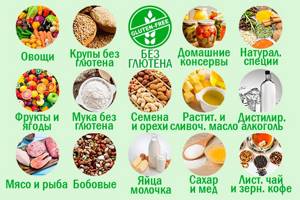
For those who are gluten intolerant or sensitive, a gluten-free diet becomes a part of life. People with celiac disease use table number 4, which is prescribed to patients with intestinal diseases with diarrhea. Products with gluten, even in small quantities, as well as products with hidden gluten are prohibited.
Authorized products:
- Vegetables, including potatoes, mushrooms
- Fruits and berries. Bananas are also possible, but sometimes patients with celiac disease experience a cross-allergic reaction, which is confused with gluten. Most often, bananas can be eaten on a gluten-free diet.
- Greenery
- Meat and fish
- Gluten Free Cereals – rice, corn, quinoa, oats (oatmeal labeled “gluten free”), buckwheat, amaranth, sorghum, millet, teff, flax, tapioca, arrowroot
- Gluten-free flour - rice, corn, buckwheat, soy, bean, coconut, potato, almond, amaranth, nut, pumpkin, lentil
- Potato and corn starch
- Legumes
- Seeds and nuts
- Eggs and dairy products (milk, sour cream, cream, kefir, cottage cheese, cheeses - if you are sure that there are no additives or they are homemade)
- Sugar and honey
- Loose leaf tea and coffee beans
- Homemade canned food and pickles
- Vegetable oil and butter without adding flour or thickeners
- Foods that typically contain gluten but are made specifically for gluten-free people (gluten-free pasta, oatmeal)
- Distilled alcohol
- Natural spices.
Sample gluten-free menu for the week
While following a gluten-free diet, you can consume any permitted foods, in any quantities and at any time.
Gluten-free diet - recipes recommended by nutritionists:
- vegetarian soups (vegetable, mushroom);
- meat broths;
- boiled porridge, potatoes;
- dairy products;
- salads and seafood;
- fresh, boiled or baked vegetables;
- hard-boiled eggs, steam omelettes;
- boiled, stewed or baked meat;
- fruits and berries, jelly;
Monday
- Breakfast: poached fish with mashed potatoes, tea.
- Lunch: light broth, steamed cutlets with rice.
- Afternoon snack: fruit salad.
- Dinner: buckwheat pudding with fresh vegetables.
Tuesday
- Breakfast: boiled meat with buckwheat porridge, tea.
- Lunch: vegetable soup, fruit jelly and fresh vegetables.
- Afternoon snack: baked apple, preferably with nuts.
- Dinner: boiled meat with rice, rosehip infusion.
- Breakfast: corn flakes, cottage cheese, tea or cocoa.
- Lunch: fish soup or fish soup, baked chicken fillet with buckwheat porridge, black tea.
- Afternoon snack: rice bread with jam, tea.
- Dinner: vegetable stew, gluten-free bread, kefir.
Thursday
- Breakfast: light omelet, cheese, tea.
- Lunch: broth, celery and apple salad, juice.
- Afternoon snack: fruit jelly and compote.
- Dinner: buckwheat pudding with vegetable side dish, green tea.
Friday
- Breakfast: cottage cheese enriched with calcium, baked apple, tea.
- Lunch: steamed cutlets with milk sauce, meat broth.
- Afternoon snack: fruit.
- Dinner: steamed fish cutlets with mashed potatoes, juice.
Saturday
- Breakfast: poached fish with rice, coffee.
- Lunch: broth with meatballs, baked vegetables, tea.
- Afternoon snack: gingerbread with nuts and apples.
- Dinner: boiled meat with buckwheat porridge, kefir.
Sunday
- Breakfast: fruit, cottage cheese, tea or juice.
- Lunch: meat broth, pilaf, vegetable salad, juice.
- Afternoon snack: fruit jelly.
- Dinner: buckwheat pudding, vegetables, tea.
1 day
- Breakfast: cottage cheese dessert with natural fruits, honey, rice cakes, natural cocoa.
- Lunch: baked fish with herbs, mashed potatoes, green salad, berry compote.
- Afternoon snack: lean corn flour bun, natural jam, natural coffee with milk.
- Dinner: millet porridge, kefir.
Day 2
- Breakfast: rice porridge with fresh berries, almond flour bun, natural coffee with milk.
- Lunch: meat borscht or cabbage soup.
- Afternoon snack: rice or cornbread, fruit salad.
- Dinner: buckwheat porridge with goat milk, soy bread.
Day 3
- Breakfast: cheese omelet, corn tortilla, cocoa.
- Lunch: chicken broth, buckwheat pancakes with meat.
- Afternoon snack: banana, tea.
- Dinner: stewed vegetables with sour cream, freshly squeezed juice.
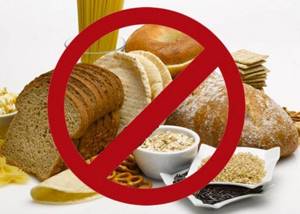
4 day
- Breakfast: corn flakes with milk.
- Lunch: fish soup with boiled egg, stewed beans.
- Afternoon snack: baked apple with nuts.
- Dinner: cottage cheese casserole with rice flour, tea.
5 day
- Breakfast: pancakes made from a mixture of rice and corn flour, cocoa.
- Lunch: creamed cheese and spinach soup, tomato and cucumber salad, boiled breast.
- Afternoon snack: boiled egg, berry juice.
- Dinner: Baked vegetables with cheese, tea.
Day 6
- Breakfast: rice and boiled fish, tea with milk.
- Lunch: meat broth and meatballs, steamed vegetables.
- Afternoon snack: fruit juice jelly, buckwheat bread.
- Dinner: buckwheat porridge and boiled meat, tea.
- Breakfast: low-fat cottage cheese, cocoa.
- Lunch: vegetable soup, baked fish in milk sauce.
- Afternoon snack: muesli of nuts, apple and rice flakes, tea.
- Dinner: vegetable stew
Labeling products containing gluten
There is an international standard according to which food products are considered gluten-free. There may be gluten in such products, but not more than 20 ppm (20 mg/kg). Exceeding this amount of gluten in a product can cause a pathological process in the intestines in people with celiac disease. There are no exact product control standards. Therefore, some manufacturers put the inscription “gluten free” or use a special sign, but in fact gluten may be present in these products. This is due to the production process, where gluten-free and gluten-free products are produced in the same production facility, as well as the transportation and storage process. A customer may receive a product labeled “gluten free” with more than 20 ppm of gluten. This applies to products of all categories.
When a product belongs to a specialized category, the manufacturer is required to obtain a Certificate of State Registration confirming the possibility of using this product to treat patients with celiac disease. This document places strict requirements on the composition.
Why do you have to make friends with labels?
Due to the complexity of the manufacturing process of various products, due to transportation or storage, some products that do not contain gluten may become gluten-free. That is why on a gluten-free diet you will have to study the information on the packaging.
For example, quinoa is a gluten-free grain. However, due to cross-contamination, quinoa may contain traces of gluten. A conscientious manufacturer usually reports this. On a strict gluten-free diet, this product will have to be excluded.
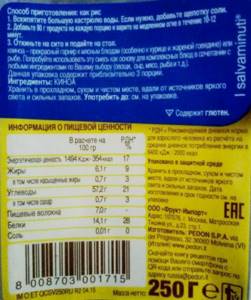
Another example is with cornbread, which contains only corn and sea salt. Corn is allowed, salt is also not prohibited, but the packaging contains the inscription “May contain traces of soy, gluten, lupine.” The manufacturer makes such notes if the company produces different products.

On some foreign products, Russian stickers with translated information are pasted on top. So, some information may be lost, especially something as important for some people as information about gluten content.



